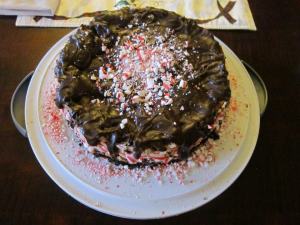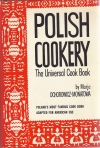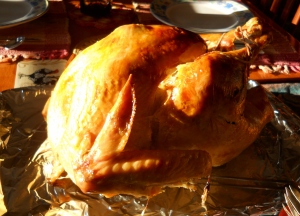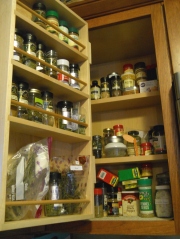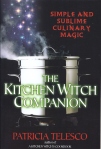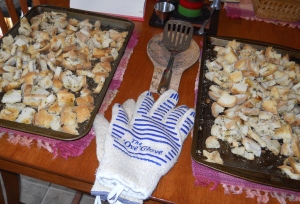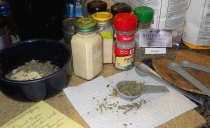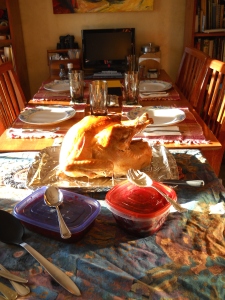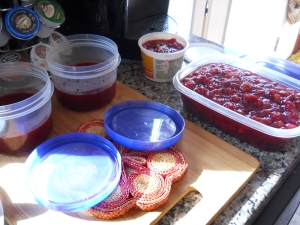I imagine readers have figured out that the holidays took over my life, timewise, which resulted in no blogposts since a couple about our Thanksgiving feast weeks ago. More to come, but possibily not for a few days. (Here’s a tease: I’m hoping daughter Kristen will do a blogpost, or at least provide the recipe, for the awesome peppermint cheesecake she baked this year for Christmas Eve lunch.)
Tomorrow, the Feast of the Epiphany, brings a few more family members to our house and I’ll be prepping for that. I am, however, somewhat copping out on this one: so tired of cooking, baking, making-everything-nice that I’ve scheduled the gathering as mid-afternoon, snacks-only. And many of those will be from-the-freezer-case items or straight from grocery aisles I usually don’t bother much with in recent years. There will also be cheese and crackers. Probably hummus, salsa and nachos as well.
Brother George and wife Heidi are expected. Niece Chrissy (Heidi’s daughter) and her husband Chad, plus the four kids from their household are also coming. We didn’t get to see them on Christmas as all of us were heading in different directions this year. Nephew Matt (George’s son) and wife Kate, with their two young’uns Alex and Ella, won’t be joining us tomorrow but that’s fine – we did Christmas Eve lunch at their home (and a fine meal that was- mostly prepared by Matt) and exchanged gifts that afternoon. I made some homemade focaccia for that meal (a first for me), and Kristen’s cheesecake was a wonderful and ultra-filling dessert to close it out. We missed George and Heidi that day, however, as they arrived just minutes after we’d departed for home!
I’m looking forward to tomorrow’s batch of kids – I have become, per my brother, “the aunt who gives books.” Each child gets two of them this year along with an inexpensive toy (went a little overboard). I probably have more fun selecting those volumes than the kids do opening them!
If I had any energy left, I’d be baking some kind of cookies honoring Italy’s “Christmas Witch” or, to be more accurate, La Befana, the Witch of the Epiphany. Two or three years ago, when I was writing “goddess journal entries” about goddess-as-archetype and sharing them with a few friends, I somehow came upon La Befana. That discovery resulted in my creating an extensive e-journal entry about her. At the beginning of each entry, I always included an original poem about the entry’s g-archetype. Here’s my humble poetic creation about Italy’s famous holiday witch:
Sonnet for Befana, Witch of the Epiphany
Shadow sweeps across frozen yellow moon,
ragged cloak trailing soot of workworn days.
Befana, mounted, rides astride straw broom,
sharp-eyed despite the chilling winter haze.
She stills a howling wind, clears ice, melts snow –
while packing a bag more joy-filled than tears.
Most wishes She grants, detests the word No;
Stockings well-filled, she smiles, then disappears.
Santa’s got nothin’ o’er this wild old hag,
not loud ho-hos nor reindeer attractions,
for witches own magic – a well-known fact!
Sure work might delay her, too long a lag?
Adjustments she’ll make for odd distractions
so long as by morn She’s emptied that sack.by Marilyn Zembo Day
Here’s the beginning of my 2011 La Befana e-entry:
She is folklore and She is goddess. She is Christian and She is Pagan. She can scare you – if you judge only by physical attributes – and yet you might await Her arrival on the edge of a child‘s excited anticipation. The ugly, soot-sodden hag Befana is the woman who won‘t disappear from Italian traditions, having survived the fall of the Roman Empire, the witch hunting crazes of the Catholic Church, devastating wars and deprivations, and some of the worst of patriarchal times. Just when you think the Yule holidays are done-for, She makes Her appearance, a smiling, female Santa Claus of ancient and modern times.
What?!!, you might say, Santa Claus? Witches are for Halloween, not Christmas time! And you’d be right… and wrong. Witches are among us always. We are all witches. We are all magick.
Google La Befana and Italy to see what you come up with, but I must tell you that I particularly love this video of DisneyWorld’s Epcot La Befana performance. Such fun! Check out the Witch of the Epiphany! She turned down the chance to travel with the Wise Men to honor the newborn Christ Child because she was busy “sweeping out the old, in the new” with her broom, before the coming Solstice/New Year. Then she tried to find the Child herself, bearing gifts. Unsuccessful, she vowed to bring gifts to all children she could find, until she came upon the Saviour. She does this every year on the eve of the Epiphany.
Today, the only “feast” shared on KitchenCauldron is this WildWoman of the Feast of the Epiphany… and statistics about the “feast” I’ve provided for you over the last 12 months, comprised of a smidgen of recipes I’ve prepared this year, served to friends and family, and photographed for this blog. WordPress provides its bloggers with the past year’s statistics in a report about their blog, and I’m offering them here for you to peruse (see below).
Thank you, all, for checking out KC (over 5700 hits!). I hope you’ve enjoyed my family and other stories, as well as the many recipes and food-related book and event entries. Hopefully, you’ve tried making a few of the dishes and baked goods (perhaps with your own creative twists and touches) and you’ve shared them in a comfortable space with your own circles of loved ones. It gives me pleasure to imagine such a scene.
Here’s to a healthy, happy, prosperous 2013 for all of us… with more recipes, stories and sharing throughout!

May the New Year be full of light and love for you and your loved ones. (Artist Trading Card #55, “Candle Comfort” by MariLyn)
*****
Here’s what the WordPress.com stats helper monkeys prepared, as a 2012 annual report, for this blog:
Here’s an excerpt:
600 people reached the top of Mt. Everest in 2012. This blog got about 5,700 views in 2012. If every person who reached the top of Mt. Everest viewed this blog, it would have taken 10 years to get that many views.



